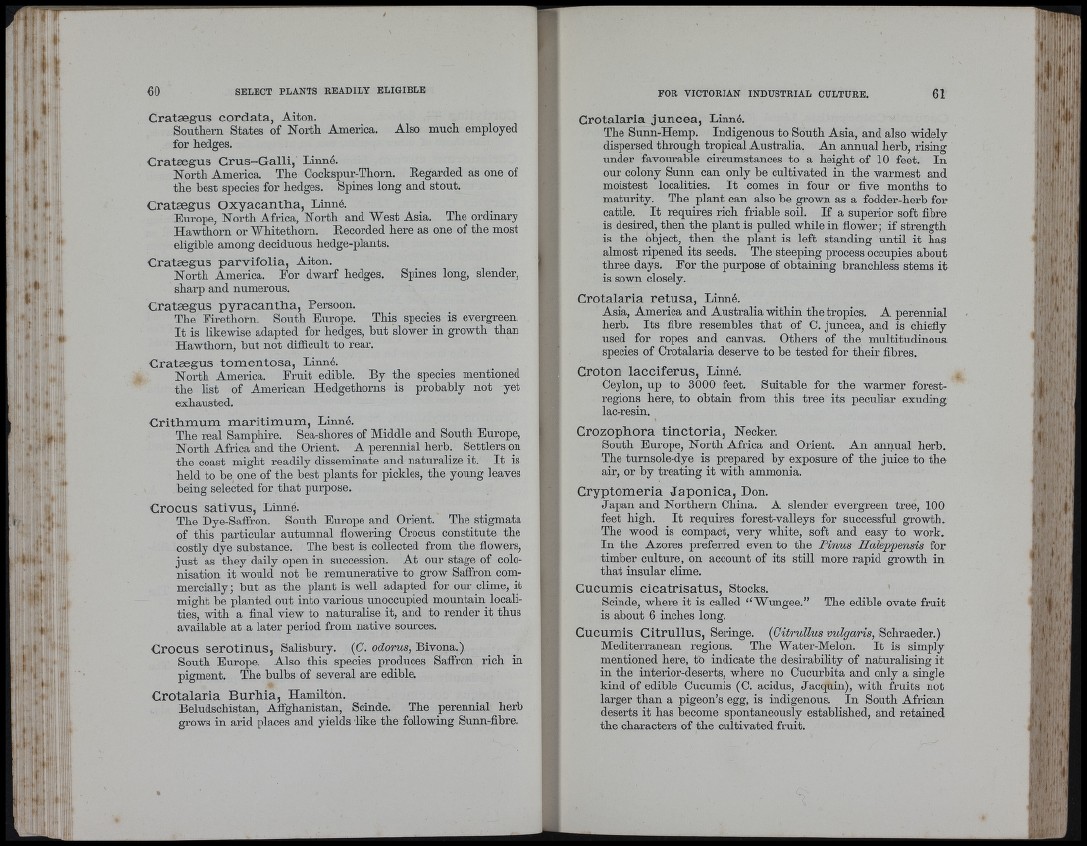
<
S i y 11«»;.
ai:
Tt
-:■* '1
: il
M Ht-
Cratægus cordata, Aiton.
Southern States of North America. Also much employed
for hedges.
Cratægus Crus-Galli, Linné.
North America. The Cockspur-Thorn. Regarded as one of
the best species for hedges. Spines long and stout.
Cratægus Oxyacantha, Linné.
Europe, North Africa, North and West Asia. The ordinary
Hawthorn or Whitethorn. Recorded here as one of the most
eligible among deciduous bedge-plants.
Cratægus parvifolia, Aiton.
North America. For dwarf hedges. Spines long, slender,
sharp and numerous.
Cratægus pyracantha, Persoon.
The Firethorn. South Europe. This species is evergreen,
I t is likewise adapted for hedges, but slower in growth than
Hawthorn, but not difficult to rear.
Cratægus tomentosa, Linné.
North America. Emit edible. By the species mentioned
the list of American Hedgethorns is probably not yet
exhausted.
Crithmum maritimum, Linné.
The real Samphire. Sea-shores of Middle and South Europe,
North Africa and the Orient. A perennial herb. Settlers on
the coast might readily disseminate and naturalize it. I t is
held to be one of the best plants for pickles, tbe young leaves
being selected for that purpose.
Crocus sativus, Linné.
The Dye-Saffron. South Europe and Orient. The stigmata
of this particular autumnal flowering Crocus constitute the
costly dye substance. The best is collected from the flowers,
just as they daily open in succession. A t our stage of colonisation
it would not be remunerative to grow Saffron commercially;
but as tbe plant is well adapted for our clime, it
might be planted out into various unoccupied mountain localities,
with a final view to naturalise it, and to render it thus
available at a later period from native sources.
Crocus serotinus, Salisbury. (G. odorus, Bivona.)
South Europe. Also this species produces Saffron rich in
pigment. The bulbs of several are edible.
Crotalaria BurRìa, Hamilton.
Beludschistan, Affghanistan, Scinde. The perennial herb
grows in arid places and yields like the following Sunn-fibre.
Crotalaria júncea, Linné.
The Sunn-Hemp. Indigenous to South Asia, and also widely
dispersed through tropical Australia. An annual herb, rising
under favourable circumstances to a height of 10 feet. In
onr colony Sunn can only be cultivated in the warmest and
moistest localities. I t comes in four or five months to
maturity. The plant can also be grown as a fodder-herb for
cattle. I t requires rich friable soil. I f a superior soft fibre
is desired, then the plant is pulled while in flower; if strength
is the object, then the plant is left standing until it has
almost ripened its seeds. The steeping process occupies about
three days. For the purpose of obtaining branchless stems it
is sown closely.
Crotalaria retusa, Linné.
Asia, America and Australia within the tropics. A perennial
herb. Its fibre resembles th a t of C. júncea, and is chiefly
used for ropes and canvas. Others of the multitudinous,
species of Crotalaria deserve to be tested for tbeir fibres.
Croton lacciferus, Linné.
Ceylon, up to 3000 feet. Suitable for the warmer forest-
regions here, to obtain from this tree its peculiar exuding
lac-resin.
Crozophora tinctoria, Necker.
South Europe, North Africa and Orient. An annual herb.
The turnsole-dye is prepared by exposure of the juice to the
air, or by treating it with ammonia.
Cryptomeria Japónica, Don.
Japan and Northern China. A slender evergreen tree, 100
feet high. I t requires forest-valleys for successful growth.
Tbe wood is compact, very white, soft and easy to work.
In the Azores preferred even to the Finns Haleppensis for
timber culture, on account of its still more rapid growth in
that insular clime.
Cucumis cicatrisatus, Stocks.
Scinde, where it is called “Wnngee.” The edible ovate fruit
is about 6 inches long.
Cucumis Citrullus, Seringe. {Citrullus vulgaris, Schraeder.)
Mediterranean regions. The Water-Melon. I t is simply
mentioned here, to indicate the desirability of naturalising it
in the interior-deserts, where no Cucúrbita and only a single
kind of edible Cucumis (C. acidus, Jacquin), with fruits not
larger than a pigeon’s egg, is indigenous. In South African
deserts it has become spontaneously established, and retained
the characters of the cultivated fruit.
s \
'-Î1 ‘ i
r - . 1 ■ 1
1«: .4
Í
Í:'. I-**
'